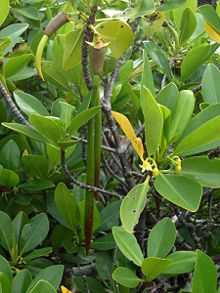Rhizophora
| Rhizophora | |
|---|---|
 | |
| Rhizophora mangle | |
| Scientific classification | |
| Kingdom: | Plantae |
| (unranked): | Angiosperms |
| (unranked): | Eudicots |
| (unranked): | Rosids |
| Order: | Malpighiales |
| Family: | Rhizophoraceae |
| Genus: | Rhizophora L.[1] |
| Species | |
|
Several, see text | |
| Synonyms | |
|
Mangium Rumph. ex Scop.[1] | |
Rhizophora is a genus of tropical mangrove trees, sometimes collectively called true mangroves. The most notable species is the red mangrove (Rhizophora mangle) but some other species and a few natural hybrids are known. Rhizophora species generally live in intertidal zones which are indundated daily by the ocean. They exhibit a number of adaptations to this environment, including stilt-roots that elevate the plants above the water and allow them to respire oxygen even while their lower roots are submerged, and a cytological molecular "pump" mechanism that allows them to remove excess salts from their cells. The generic name is derived from the Greek words ριζα (rhiza), meaning "root," and φορος (phoros), meaning "bearing," referring to the stilt-roots.[2]
The beetle Poecilips fallax is a common pest of these trees.
The red mangrove is the state tree of Delta Amacuro in Venezuela; a dark brown dye can be produced from it, which is used in Tongan ngatu cloth production.
Selected species
- Rhizophora apiculata Blume – bakauan lalaki (Philippines) bakau minyak
- Rhizophora harrisonii Leechm.
- Rhizophora mangle L. – red mangrove, tongo (Tonga)
- Rhizophora mucronata Lam. – red mangrove
- Rhizophora racemosa G.Mey.
- Rhizophora samoensis (Hochr.) Salvoza
- Rhizophora stylosa Griff. – spotted mangrove, bakauan bato (Philippines)[3] Te tongo (Kiribati),[4] Đâng (Vietnam)
Hybrids
- Rhizophora × annamalayana Kathiresan (R. apiculata × R. mucronata)
- Rhizophora × lamarckii Montrouz. (R. apiculata × R. stylosa)[3]
- Rhizophora × selala (Salvoza) P.B.Tomlinson (R. mangle × R. stylosa)
Formerly placed here
- Aegiceras corniculatum (L.) Blanco (as R. corniculata L.)
- Bruguiera gymnorhiza (L.) Savigny (as R. gymnorhiza L.)
- Bruguiera parviflora (Roxb.) Wight & Arn. ex Griff. (as R. parviflora Roxb.)
- Bruguiera sexangula (Lour.) Poir. (as R. sexangula Lour.)
- Ceriops tagal (Perr.) C.B.Rob. (as R. tagal Perr.)[3]
See also
- Changes in global mangrove distributions
- Ecological values of mangrove
References
| Wikimedia Commons has media related to Rhizophora. |
| Wikispecies has information related to: Rhizophora |
- ↑ 1.0 1.1 "Genus: Rhizophora L.". Germplasm Resources Information Network. United States Department of Agriculture. 2006-05-12. Retrieved 2010-11-27.
- ↑ Austin, Daniel F. (2004). Florida Ethnobotany. CRC Press. p. 964. ISBN 978-0-8493-2332-4.
- ↑ 3.0 3.1 3.2 "GRIN Species Records of Rhizophora". Germplasm Resources Information Network. United States Department of Agriculture. Retrieved 2010-11-27.
- ↑ "Kiribati Country Report to The Conference of Parties (COP) of The Convention on Biological Diversity (CBD)". Environment and Conservation Division, Ministry of Environment, Lands and Agricultural Development. p. 5. Retrieved 28 November 2012.